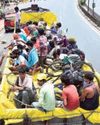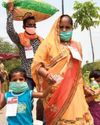
As the country enters the fourth phase of lockdown, albeit with the easing of many restrictions and opening up of some essential economic activities, it is still not out of the COVID-19 woods. With the total number of confirmed cases (as against the true number of infections) standing at 1,12,359 as of May 21, the caseload is still increasing at the rate of over 5,000 cases a day. Although the graph may appear to be showing some signs of levelling off, given the past trend, it is not certain that it may begin to decline soon.
The growth factor—the ratio of increases in caseloads on two consecutive days—has continued to remain mostly a little over 1, which means we are still in the exponential phase (Fig. 1). Of course, the national picture reflects the situation in some problem States. Barring Punjab, the other States that were discussed in the Frontline issue dated May 22 continue to be problematic. Moreover, Madhya Pradesh and Rajasthan, whose trajectories had seemed to bend down from the exponential phase are now showing signs of trend reversal. Of serious concern will be the case of West Bengal, which will be subjected to the double whammy of COVID-19 and the supercyclone “Amphan”. The cyclone’s landfall and its continuing north-north-eastward trajectory over land, which has just passed 270 kilometres north-north-east of Kolkata into Bangladesh, with wind speeds touching 70-80 kmph, is likely to result in widespread devastation of life and property in and around that region.
This story is from the {{IssueName}} edition of {{MagazineName}}.
Start your 7-day Magzter GOLD free trial to access thousands of curated premium stories, and 9,000+ magazines and newspapers.
Already a subscriber ? Sign In
This story is from the {{IssueName}} edition of {{MagazineName}}.
Start your 7-day Magzter GOLD free trial to access thousands of curated premium stories, and 9,000+ magazines and newspapers.
Already a subscriber? Sign In

How Not To Handle An Epidemic
The lockdowns were meant to buy time to put in place appropriate health measures and contain the coronavirus’ spread, but they have failed to achieve the objective and heaped immense misery on the marginalised sections of society. India is still in the exponential phase of the COVID-19 infection and community transmission is a reality that the government refuses to accept.

Tragedy on foot
As the COVID-19-induced lockdown cuts the ground beneath their feet in Tamil Nadu, thousands of migrant workers are trudging along the highway to the relative safety of their upcountry homes.

Sarpanchs as game changers
Odisha manages to keep COVID-19 well under control because of the strong participation of panchayati raj institutions and the community at the grass-roots level under the leadership of Chief Minister Naveen Patnaik.

Scapegoating China
As the COVID-19 death rate spikes and the economy tanks in the United States, Donald Trump and his advisers target China and the World Health Organisation with an eye to winning the forthcoming presidential election.

New worries
Kerala’s measured approach to the pandemic and lockdown has yielded results. But it still has to grapple with their huge economic impact on its economy, which it feels the Centre’s special financial relief package does little to alleviate.
No love lost for labour
Taking advantage of the lockdown and the inability of workers to organise protests, many State governments introduce sweeping changes to labour laws to the detriment of workers on the pretext of reviving production and boosting the economy.

Capital's Malthusian moment
In a world that needs substantial reorienting of production and distribution, Indian capital is resorting to a militant form of moribund neoliberalism to overcome its current crisis. In this pursuit of profit, it is ready and willing to throw into mortal peril millions whom it adjudicates as not worth their means—an admixture of social Darwinism born of capital’s avarice and brutalism spawned by Hindutva. .

Understanding migration
When governments and their plans are found to be blatantly wanting in addressing reverse migration, exercises such as the Ekta Parishad’s survey of migrant workers throughout India can be useful to work out creative long-lasting solutions.

Waiting for Jabalpur moment
The Supreme Court’s role in ensuring executive accountability during the ongoing lockdown leaves much to be desired. Standing in shining contrast is the record of some High Courts.

An empty package
The Modi regime, which has been unable to control the COVID-19 infection, restore economic activity and provide relief to millions exposed to starvation, trains its sights on Indian democracy, making use of the panic generated by fear and a lockdown that forecloses paths of resistance.